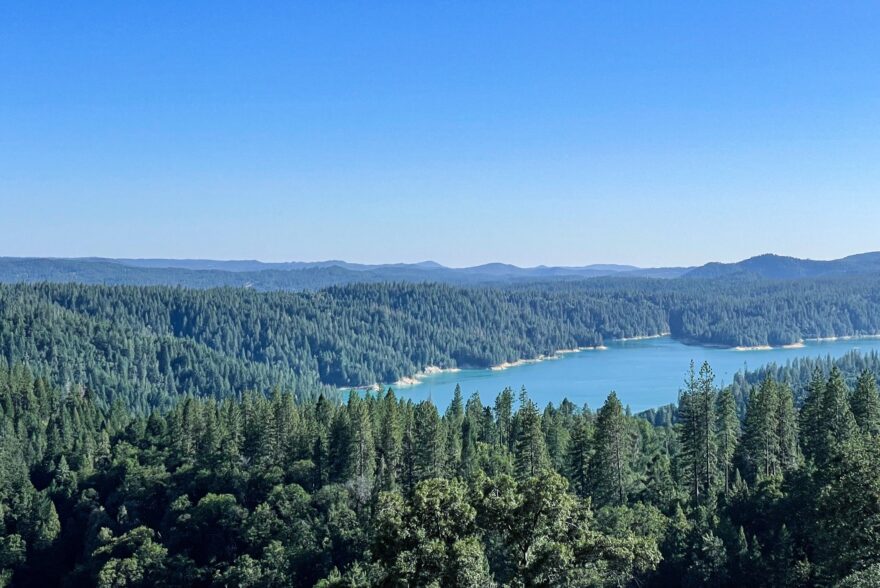Apr. 2023 Science Corner | Forest management for healthy headwaters


Healthy forests are critical for clean, reliable water supply, with almost half of our nation’s water supply originating in forests. Many western U.S. forests that provide water are also at high risk for disturbances like severe wildfire and drought due to the legacy of fire suppression, climate change, and land use and management impacts.
“How Blue Forest is using hydrologic modeling to link forest restoration to water supply investments”
Written by: Kim Seipp, PhD and Tessa Maurer, PhD
Healthy forests are critical for clean, reliable water supply, with almost half of our nation’s water supply originating in forests. Many western U.S. forests that provide water are also at high risk for disturbances like severe wildfire and drought due to the legacy of fire suppression, climate change, and land use and management impacts. Forest management, which includes prescribed burning, mechanical thinning, meadow restoration, and a host of other activities, is a widely accepted tool for improving the condition of these critical forested headwaters.
In addition to protecting water quality by preventing contamination after severe wildfires, forest management can enhance water supply reliability in some geographies by increasing runoff. Removing small diameter trees from overcrowded forests means that the water those trees would use to grow is instead available for groundwater recharge and streamflow. This additional runoff can be beneficial for drinking water and hydroelectric utilities.
To better understand the potential for additional runoff through forest management, our partners at the Sierra Nevada Research Institute developed a model to forecast the water quantity benefits of forest restoration. The modeling approach is based on remote sensing, using satellite imagery to measure conditions on the ground. We recently developed a science brief describing in detail how this methodology works.
The model benchmarks water supply based on vegetation water use. Through remote sensing data, we can calculate how much water trees and other vegetation are using within a watershed, and we can see how that changes as forest management projects move forward. That decrease in water use by trees gives us an estimate of how much additional water supply will be available. Using a remote sensing approach is key to making this calculation possible for most of our projects: it lowers the cost dramatically and ensures that the necessary data are available across California, not just where we have on-the-ground sensors.
Water supply benefits of forest management are particularly important for Blue Forest’s work, since the Forest Resilience Bond was developed in part to bridge the gap between water managers and forest land managers like the U.S. Forest Service to ensure healthy headwaters. Water resource managers and hydroelectric generators have a stake in accelerating the pace and scale of management in their source watersheds given both the water supply and water quality benefits of management. However, in the western U.S., more than half of our water supply comes specifically from forested land that is owned by the federal government rather than by water utilities themselves. The FRB provides a means for water utilities to be active participants in protecting their source watersheds.
To get involved, many water utilities want to see demonstrated benefits. This is where the water supply model comes in: by providing these utilities with the information they need to make informed contributions, the model helps translate project impacts into monetary contributions to management. For example, the involvement of Yuba Water Agency in the first Forest Resilience Bond, Yuba I, was grounded in forecasted water supply benefits to the utility.
Each year, we measure those benefits to see how well our forecasts estimated the benefits and share those results with Yuba Water. Dr. Phil Saksa, Chief Scientist at Blue Forest, recalled that “In working with Yuba Water on quantifying the water supply benefits of forest restoration, the utility saw an opportunity to evaluate multiple benefits of headwater forest restoration, in addition to the value provided by wildfire risk reduction to their source watershed and communities within the North Yuba River.”
As Blue Forest expands our project pipeline of Forest Resilience Bonds under development, we are further leveraging this tool to evaluate the potential water supply benefits to other water and hydroelectric utilities across California. “Making ever-better watershed investment decisions in California will depend on our ability to articulate and measure the benefits of forest management. Resources like this science brief can help the hundreds of water utilities in California evaluate opportunities to align their resources with watershed maintenance activities, like forest management,” described Matt Sojholm, Blue Forest’s Project Development Director for California.
Our FRB pipeline also includes multiple potential projects in Oregon, Washington, Montana, and beyond. While the current model is calibrated to the Sierra Nevada, we are looking forward to expanding the model to other geographies across the Western U.S. based on utility interest. These water resource models can be used to inform utility involvement in the Forest Resilience Bond, and we are excited to develop more collaborative approaches to protecting our headwaters.